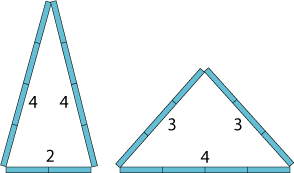Copyright © University of Cambridge. All rights reserved.
'Sticks and Triangles' printed from https://nrich.maths.org/
Show menu
Why do this problem?
Possible approach
You could start by showing the problem as it is given from a computer or print out of the text. Alternatively, you could hand out sticks and ask the group what is the least number of sticks they will need to make a triangle. Then ask them to see if they can make a triangle with four sticks. It might be a good idea at this point to make quite sure that all the group know that a triangle has three straight sides!
At the end there should be time to discuss their findings. Ask them for which numbers of sticks did they find the most triangles? Can they think why this should be so?
Things to draw out from this activity include:
Key questions
How are you going to record your findings?
Are you sure you have found all the possible triangles with that number of sticks?
Whatever number of sticks you are trying, it would it be a good idea to start by trying to make a triangle which has just one stick as a side.
How many sticks have you along the base of that triangle?
Could you try another number of sticks along the base?
Can you see any differences between odd and even numbers of sticks?
What about looking at numbers of sticks which are multiples of three?
Possible support
Suggest that learners who find this problem difficult work steadily with real sticks starting with triangles with three sticks and working upwards. Drawing what they have done is probably the easiest way to record but it might be helpful to show them how a table can be made of their results. It may be helpful for children to have had a go at the task Let's Investigate Triangles as a precursor to this one.
Possible extension
Learners could make a table of results and formulate any 'rules' for when it is possible to construct a triangle and when it is not possible. They could then predict the numbers of triangles they should be able to make for 21 to 30 sticks and then test their predictions.

